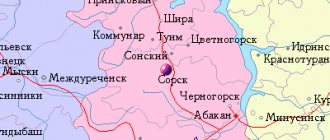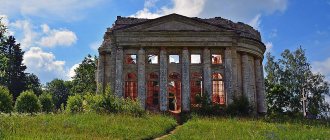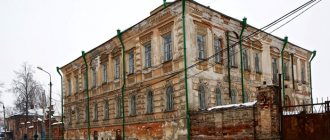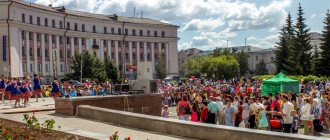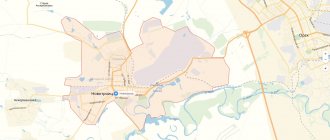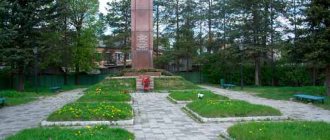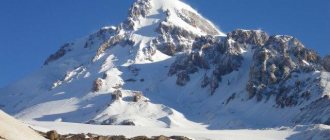Material from Orlets, free Oryol encyclopedia
Jump to: navigation, search
| MOAR!!! This article lacks photos of the subject and the lulz associated with it ! I'll forward them to this thread! |
Globe of Maloarkhangelsk.
Photo from the site https://maloarhangelsk.ru/ Maloarkhangelsk
(Malik)
is an Orthodox town 82 km south of Orlets, with a population of just under 4,000 people.
The railway station of the same name on the Moscow-Kursk Railway is located 14 km from Maloarkhangelsk, which can be covered by a comfortable PAZ bus.
Sabzh has 2 schools and an Orthodox vocational school that trains tractor drivers and cooks. In schools there are 10-12 sad goblins and goblins in each stream. Soon after passing the Unified State Exam, they join the orderly ranks of students in Orlets and Nerezinovsk, as well as in the Republic of Armenia. The most selected ones are awarded the right to join the contingent of local alcohol.
At the exit from Maloarkhangelsk towards Kolpna there is a good, suitable lake with places for drinking divine nectar in the form of tables with benches.
The road from the regional center to Sabzh is quite decent, apparently due to the frequent visits of our glorious governor. And further towards Kolpna there is a complete alley or kaput.
[edit] A little history
Maloarkhangelsk was named the city with the light hand of Catherine in 1778. I received the prefix “Little” so as not to be confused with northern Arkhangelsk. One of the undoubted achievements of the bloody tsarist regime: they turned out completely different.
Maloarkhangelsk is a small settlement whose population in its history has never exceeded 8 thousand people. The average number of inhabitants is 4,000 people: approximately the same number lived here when it was founded in 1778, the same number were discovered in the mid-19th century, the twentieth century regularly confirmed the stability of the number of residents loyal to the city. Someone comes, someone dies, whites, reds, serfdom, Soviet power, and start counting - the enchanted 4 thousand.
Stability or stagnation? There are different opinions. To understand the situation, it’s good to delve into history. Old people say that at the beginning of the 19th century Pushkin happened to be passing through Maloarkhangelsk. A strange gentleman in a head cylinder caused a stir among the local population; In the morning, thousands of people gathered at the doors of the inn, mistaking the great poet for a visiting auditor. Allegedly, Pushkin then told Gogol about this story, and he immediately wrote his “The Inspector General.”
The curious story does not have documentary evidence, but it perfectly rhymed with another plot, as if it had already happened in 1919. At least the same old people swear that it was so. During the days of the Civil War, a group of disguised Red Army soldiers, disguised as White Guards, entered the city and for some time behaved completely like the White Guards: they signed up volunteers for the White Army, walked widely and in every possible way emptied the tables of hospitable townspeople. When the city finally warmed up to the “White Guards” of the partisan Makharadze, a rally with blackjack and whores, a parade of troops, was held on the main square of the city. Everyone gathered, and it turned out just fine: a wave of Sandro Makharadze’s hand set into motion the vocal cords of hundreds of partisans lined up for the parade. The repertoire stung the townspeople to the very soul: partisans dressed in White Guard uniforms sang “The Internationale”. The story with Pushkin repeated itself.
Some narrow-minded shorties find in these two stories (and there are others) confirmation of the thought lying on the surface: how spineless they are. Meanwhile, deep in the plot lies the answer to many contemporary questions. For example, in the recent elections to the State Duma, the district gave two-thirds of the votes to United Russia. Why?
A possible answer looks like this: the settlement, located away from major roads, welcomes every guest on whose path it happens to be. Pushkin? Ours for you with a brush. Martynov? Sit down at the table, my dear, tell us about your rare meetings with the poet Lermontov. White Guards? Guys, wait a little, now we’ll wipe the floor after the Red Army soldiers and properly discuss the Sivash operation. Medvedev, Brezhnev, Petrarch, United Russia, Liberal Democratic Party - everyone has a kind word, a plate of jellied meat and a glass.
They will come and leave, but the city does not change at all: potatoes are still harvested in the fall, and in the summer there is fishing and the Colorado potato beetle, and in the fall there is a season for moonshine brewing and mushroom picking, and then winter. Someone arrived, someone left, 4 thousand remained. What is there again: the Reds, the elections, did they bring beer, or did Medvedev come? We need to go and have a look. Stability, for example. Stagnation, if you will. Come back more often, man.
Population[ | ]
| Population | |||||||||
| 1847[7] | 1856[8] | 1866[7] | 1897[9] | 1913[8] | 1926[10] | 1931[8] | 1939[11] | 1959[12] | 1970[13] |
| 2735 | ↗4300 | ↘3286 | ↗7785 | ↗9300 | ↘6238 | ↗6900 | ↘3497 | ↘2499 | ↗3000 |
| 1979[14] | 1989[15] | 1992[8] | 1996[8] | 1998[8] | 2000[8] | 2001[8] | 2002[16] | 2003[8] | 2005[8] |
| ↗3580 | ↗4294 | ↗4300 | →4300 | ↘4200 | ↘4100 | ↘4000 | ↘3962 | ↗4000 | ↘3800 |
| 2006[8] | 2007[8] | 2008[8] | 2009[17] | 2010[18] | 2011[8] | 2012[19] | 2013[20] | 2014[21] | 2015[22] |
| ↘3700 | →3700 | ↗3800 | ↗3862 | ↘3620 | ↘3600 | ↘3565 | ↘3520 | ↘3462 | ↘3359 |
| 2016[23] | 2017[24] | 2018[25] | 2019[26] | 2020[27] | 2021[2] | ||||
| ↘3300 | ↘3293 | ↘3276 | ↘3216 | ↘3182 | ↘3141 | ||||
One of the smallest cities in Russia: As of January 1, 2021, in terms of population, the city was in 1098th place out of 1116[28]cities of the Russian Federation[29].
National composition[ | ]
The ethnic composition of the population is predominantly Russian.
Confessional composition[ | ]
The majority of the population considers themselves Orthodox. There are also Muslims.
[edit] Urban legends
[edit] The Legend of the Brick Factory
Maloarkhangelsk stands on refractory clay, which is excellent for making bricks and other ceramic things. Orlovsky, located in the regional center, deals with ceramic items (tiles and porcelain stoneware). Big KamAZ trucks do nothing but transport it from the quarry to the plant all day long. However, the Cretaceous period, to which the deposit of refractory clays in the Maloarkhangelsk region belongs, lasted about 80 million years, and clay accumulated in abundance.
For a long time now, local residents have been trying to spend it somehow wisely. Either they make a pot or a brick - in vain. Under Soviet power, a whole brick factory tried to lime it, making a million bricks a year - there are still a lot left. In addition, the brick, the shape of which Lobachevsky and Riemann would envy, did not diverge very well in market conditions.
The plant closed, there was no point in restoring it, they decided to call the Varangians. They didn’t build anything either, but at least they delivered it. Old people like to remember how grandfather Stroev came to the opening of the plant in the 90s or something. Of course, no factory was built: there were walls, a partition divided the room approximately in half, and a hole was punched in the partition and festively decorated. A conveyor belt was sticking out of the hole. The insides of the brick production workshop were not visible from the hall, and for good reason, but more on that below.
Music was playing and cameras were chattering. After finishing his speech about how great the area would be now, grandfather pressed a button and the conveyor belt rolled out a pallet of brand new bricks. There was applause, flashes and applause. Another pallet came out. In the heads of journalists, the headlines “Big Brick Day in Maloarkhangelsk”, “Brick is Coming”, etc. were born. Having waited for the third pallet, managers at different levels stopped the conveyor, carefully took pictures against the backdrop of bricks and headed to the festive table, the press with them.
An hour later, voices were heard in the empty factory: a belated television crew had arrived. She demanded that the workers, festively dressed in blue faces, start the conveyor for a minute: they really wanted to film the solemn moment of the birth of a brick. The workers laughed a healthy working laugh and immediately organized an excursion behind the partition. There was, of course, nothing inside. Well, not absolutely nothing: there was still a conveyor belt. But there is no brick on it. Several pallets were purchased specifically for the plant’s launch ceremony, but all of them had already rolled out, and the conveyor did not provide for return. The workers advised the distressed journalists not to bother and to remove the faster-standing brick, because it would not stand there for long: there are so many people that you just have to turn away.
Removed.
Physiographic characteristics[ | ]
The southernmost city in the region, located on the Central Russian Upland in the center of the East European Plain, 81 km southeast of Orel and 14 km east of the railway station of the same name.
Time[ | ]
Maloarkhangelsk, like the entire Oryol region, is located in the MSC time zone (Moscow time). The applied time offset relative to UTC is +3:00[5].
Climate[ | ]
The city is located in the temperate continental climate zone (according to the Köppen classification - Dfb
). Winters are moderately cool, summers are unstable.
[edit] Notes
| Establishments Watercolor • Atoll • Banzai • Bistro in Salute • Botkin Hospital • Buninka • Jolly Roger • Galaxy • Grillmaster • Grinn • Grinnbeer • Grinn-film • Children's Infectious Diseases Hospital • Jam • Europe • Ershik • Zhar-Pizza • Ilyinka • Katakana • Cafe Carousel • Summer Cafe • Yagodka Cafe • Wardroom • Local History Museum • Colosseum • Del`Arabica Coffee House • Summer Stage • Champions League • Dairy Market • I Won’t Leave • New Library • Cellar • Ocean of Dreams • October • Paparazzi • Pizza in the Arch • Pobeda • Moscow Region • Santa Bean • Skazka • Contemporary • Stadium named after. Lenin • Blood transfusion station • Student and elephant • Youth Theater • Tashir • Transagency • Third floor • Third Rome • Fitness Maximum • Fitness Express • TSUM • Hours • Chester Pub • Chicago • Shipka • Extreme • DVD cafe In Orlets 1st Posadskaya • 909 block • Bus station • Alexander Bridge • Airport • White Stone • Botany • Victory Boulevard • Military unit • Forcing • GPKiO • Palace of Culture Railway • Dvoryanka • Children's park • Railway College • Green oak grove • Hippodrome • Kakhovka • Chinese Wall • Goat Park • Pet Cemetery • Komsomolskaya Square • Cosmodrome • st. Krasnoarmeyskaya • Luzhki • Mezenka • Mikron • MFC • Moskovskaya street • Bridge without a road • Drug treatment clinic • Naugorka • Nauchpribor • Oka • OKB MOPR • Orlik • Orlovskaya CHPP • Stroev’s Liver • Caves • Lenin Monument • Penevka • First Khrushchev Orlets • Flat House • Suspension bridge • Polish building of the OSU • Garbage • Tidying • Prokurovka • Overpass on Vygonka • Saburov Fortress • Bright Life • Seminarsky Park • Gurtiev Square • Ermolov Square • Tankmen's Square • Stella on the Spit • Old Jewish Cemetery • Transmash • UVM • Komsomolskaya Street • Lenin Street • Svoboda Street • COMFORT • Trefoil • Toilets • Tsvetaevka • TSNTI • Tspkh • Chaika • Devil's Ditch Orlovshchina Bolkhov • Verkhovye • Gat • Villages in the city • Zalegoshch • Znamenka • Znamenskoye • ZBK • Kromy • Livny • Maloarkhangelsk • Mtsensk • Naryshkino • Novosil • Oryol Polesie • Oryol • Steel Horse • Spasskoye-Lutovinovo • Khotynets |
Source - “/mediawiki/index.php/%D0%9C%D0%B0%D0%BB%D0%BE%D0%B0%D1%80%D1%85%D0%B0%D0%BD%D0%B3 %D0%B5%D0%BB%D1%8C%D1%81%D0%BA"
Category: Places
Famous natives[ | ]
- Alisov, Boris Pavlovich - Soviet climatologist.
- Kokuev, Nikita Rafailovich - Russian entomologist.
- Kochukov, Nikolai Sergeevich - Soviet and Russian sculptor.
- Kuleshov, Pavel Nikolaevich - Russian scientist and livestock breeder.
- Morozov, Sergei Sergeevich - Soviet geological engineer, soil scientist, soil scientist, geographer.
- Obolensky, Leonid Egorovich - Russian writer, poet, philosopher and publicist, critic, publisher.
- Tsvetaev, Vyacheslav Dmitrievich - Soviet military leader, Hero of the Soviet Union.
Notes[ | ]
- ↑ 12
Oryol Region. The total area of land of the municipality. FSGS. - ↑ 123
The permanent population of the Russian Federation by municipalities as of January 1, 2021 (Russian). Date accessed: April 27, 2021. Archived May 2, 2021. - THE USSR. Administrative-territorial division of the union republics on January 1, 1980 / Comp. V. A. Dudarev, N. A. Evseeva. - M.: Izvestia, 1980. - 702 p. — P. 192.
- Law of the Oryol Region of August 12, 2004 No. 414-OZ “On the status, borders and administrative centers of municipalities in the Maloarkhangelsk district of the Oryol region”
- Federal Law of 06/03/2011 No. 107-FZ “On the calculation of time”, Article 5 (undefined)
(June 3, 2011). - Streets of the city of Maloarkhangelsk (unspecified)
. - ↑ 1 2
Information on the website of the regional administration
(unspecified)
. Archived from the original on August 23, 2011. - ↑ 1 2 3 4 5 6 7 8 9 10 11 12 13 14
People's Encyclopedia “My City”.
Maloarkhangelsk (Oryol region) (unspecified)
. Retrieved June 18, 2014. Archived June 18, 2014. - The first general census of the Russian Empire in 1897. Novgorod province (undefined)
. Retrieved July 1, 2014. Archived July 1, 2014. - All-Union Population Census of 1926. M.: Publication of the Central Statistical Office of the USSR, 1928. Volume 9. Table I. Populated areas. Current urban and rural population (undefined)
. Date of access: February 7, 2015. Archived February 7, 2015. - All-Union Population Census of 1939. The size of the urban population of the USSR by urban settlements and intra-city areas (unspecified)
. Retrieved November 30, 2013. Archived November 30, 2013. - All-Union Population Census of 1959. The size of the urban population of the RSFSR, its territorial units, urban settlements and urban areas by gender (Russian). Demoscope Weekly. Access date: September 25, 2013. Archived April 28, 2013.
- All-Union Population Census of 1970 The size of the urban population of the RSFSR, its territorial units, urban settlements and urban areas by gender. (Russian). Demoscope Weekly. Access date: September 25, 2013. Archived April 28, 2013.
- All-Union Population Census of 1979 The size of the urban population of the RSFSR, its territorial units, urban settlements and urban areas by gender. (Russian). Demoscope Weekly. Access date: September 25, 2013. Archived April 28, 2013.
- All-Union population census of 1989. Urban population (undefined)
. Archived from the original on August 22, 2011. - All-Russian population census 2002. Volume. 1, table 4. Population of Russia, federal districts, constituent entities of the Russian Federation, districts, urban settlements, rural settlements - regional centers and rural settlements with a population of 3 thousand or more (unspecified)
. Archived from the original on February 3, 2012. - The size of the permanent population of the Russian Federation by cities, urban settlements and regions as of January 1, 2009 (unspecified)
. Retrieved January 2, 2014. Archived January 2, 2014. - All-Russian population census 2010. 7. Population of urban districts, municipal districts, urban and rural settlements, urban settlements, rural settlements of the Oryol region (undefined)
. Access date: February 1, 2014. Archived February 1, 2014. - Population of the Russian Federation by municipalities. Table 35. Estimated resident population as of January 1, 2012 (unspecified)
. Retrieved May 31, 2014. Archived May 31, 2014. - Population of the Russian Federation by municipalities as of January 1, 2013. - M.: Federal State Statistics Service Rosstat, 2013. - 528 p. (Table 33. Population of urban districts, municipal districts, urban and rural settlements, urban settlements, rural settlements) (undefined)
. Retrieved November 16, 2013. Archived November 16, 2013. - Table 33. Population of the Russian Federation by municipalities as of January 1, 2014 (unspecified)
. Access date: August 2, 2014. Archived August 2, 2014. - Population of the Russian Federation by municipalities as of January 1, 2015 (unspecified)
. Access date: August 6, 2015. Archived August 6, 2015. - Population of the Russian Federation by municipalities as of January 1, 2021 (Russian) (October 5, 2018). Date accessed: May 15, 2021. Archived May 8, 2021.
- Population of the Russian Federation by municipalities as of January 1, 2021 (Russian) (July 31, 2017). Retrieved July 31, 2021. Archived July 31, 2021.
- Population of the Russian Federation by municipalities as of January 1, 2021 (Russian). Retrieved July 25, 2018. Archived July 26, 2021.
- Population of the Russian Federation by municipalities as of January 1, 2021 (Russian). Date accessed: July 31, 2019. Archived May 2, 2021.
- Population of the Russian Federation by municipalities as of January 1, 2021 (Russian). Date accessed: October 17, 2021. Archived October 17, 2021.
- taking into account the cities of Crimea
- https://rosstat.gov.ru/storage/mediabank/bul_Chislen_nasel_MO-01-01-2021.rar Population of the Russian Federation by municipalities as of January 1, 2021 (1.85 Mb, 07/30/2021)
- Olga SUPONEVA |
Komsomolskaya Pravda website. “Turquoise Ring of Russia”: they plan to develop a new tourism brand in the Oryol region
(unspecified)
.
orel.kp.ru - Website of Komsomolskaya Pravda
(August 17, 2020). Access date: September 1, 2021.
Literature[ | ]
- Vasily AGOSHKOV. MALOARKHANGELSKY SOURCES. Historical and literary local history publication. Reader for university students. 440s. Orel-Maloarkhangelsk, 1999
- Book 1. Small Arkhangelsk city. Pages 3-278
- Book 2. Little Arkhangelsk freedom. Pages 279–440
- MALOARKHANGELSKY LOAF. Editors-compilers Pyotr ZALOZHNYH and Vasily AGOSHKOV. Collection of works by Little Arkhangelsk poets and prose writers... 80 p. Orel-Maloarkhangelsk, 1999
- Vasily AGOSHKOV. Why are the regional centers of the Oryol region named this way? Among them is the city of Maloarkhangelsk. 64с, Orel, 1999
- Victor Kuzmich VNUKOV. “I WILL NOT LEAVE MY FATHER’S BOARDS!” A book of poems and memories about the poet. To the 80th anniversary of the poet. 128 pp.
- Nikolai TETEREV. MALOARKHANGELSKOY UNDERGROUND. 196 pages. The author of the idea is V.I. Agoshkov. SPONSORS: Family and O. V. Panteleev. The city of Novomoskovsk, Tula region. N. TETEREV is also the author of the books: “On the Verge of Death” and “In the City of My Youth.”

